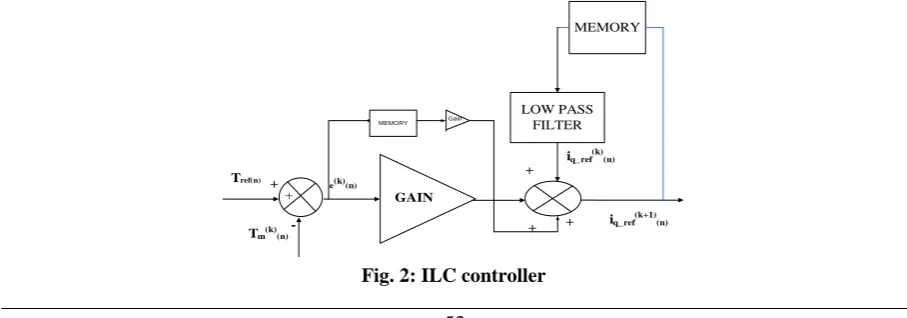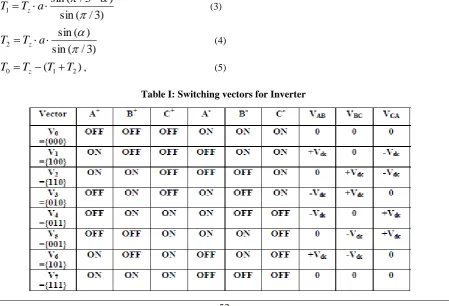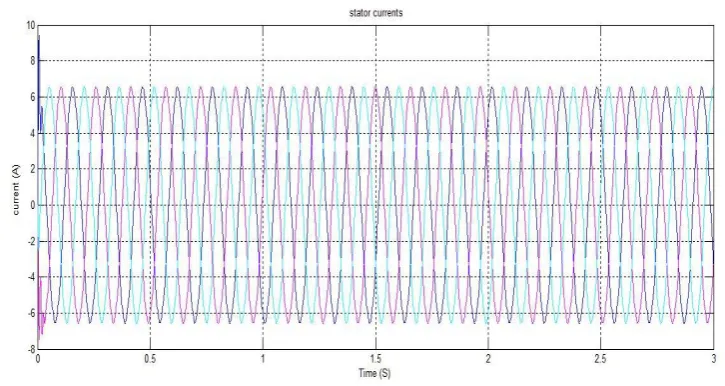e-ISSN: 2278-067X, p-ISSN: 2278-800X, www.ijerd.com
Volume 9, Issue 4 (December 2013), PP. 51-56
A Modified Iterative Learning Controller for Reducing Torque
Pulsations in Field Oriented Control Driven Permanent Magnet
Synchronous Motor
K.Jeyaprakash
1, B.Adhavan
2, C.S.Ravichandran
3PG scholar, EEE Dept, Sri Ramakrishna engineering college, Coimbatore
1Associate professor, EEE Dept, Sri Ramakrishna engineering college, Coimbatore
2Abstract:- Permanent magnet synchronous motors are mostly used in low and high power and variable speed
applications. Major disadvantage of PMSM is that the motor exhibits torque pulsations due to many factors from motor and drive. This paper proposes a modified iterative learning controller to reduce the pulsations in torque of permanent magnet synchronous motors (PMSM). Modified ILC has memory to store previous control actions and previous error. Proposed ILC scheme consists of previous and current loop gain in order to minimize the torque oscillations. Previous control actions are stored and used to reduce the steady state periodic torque pulsations. Space vector pulse width modulation is used to reduce the harmonic noise in motor current which in turn improves performance of drive. Torque error is calculated and the iqs ref current gets altered
accordingly to minimize torque variations. The simulation of the PMSM drive with field oriented control and proposed controller is done using MATLAB 2009b. The results obtained shows better reduction of torque pulsation and improved performance over conventional methods.
Keywords - PMSM, Torque Pulsation, Modified Iterative Learning Control (ILC), Space Vector Pulse Width
Modulation (SVPWM), Field oriented control (FOC).
I.
INTRODUCTION
PMSM motors plays major role in high performance servo applications, robotics and adjustable speed drives (ASDs) where torque pulsations can adversely affect the drive system performance. DC and AC induction motors are getting replaced by PMSM in the industries due to compactness, efficiency, robustness, reliability and shape adoption to the working environment power density and torque-to-inertia ratio. It is necessary to reduce these torque pulsations to increase efficiency and lifetime of drive system and to improve the production in industries. The causes of torque pulsations includes
Non-sinusoidal distribution of flux linkage,
Self and mutual inductances with harmonics,
Variable magnetic reluctance at stator slots.
An active filter (AF) with an IGBT and two RLC high-pass EMI noise filters are used to reduce the torque ripple. The filter uses the hysteresis voltage control method is used in filter and the hysteresis current control method is used in motor main circuit. In this way, it makes sure that almost sinusoidal voltage is applied to the motor termin als[2].
An extended Kalman filter with state variables stator current and PM flux to estimate the flux variations due to the non-sinusoidal flux distribution is designed. A current compensation is done to reduce the negative influence caused by demagnetization[9].
A modified periodic current reference is tracked to obtain smooth torque.In order to improve current tracking in the presence of periodic reference signals and disturbances in field oriented control driven PMSM, the repetitive current control techniques is applied. The q-axis current reference has been modified to achieve constant torque [4]. Nonlinearity of PMSM and existence of inverter makes the drive nonlinear and time-variant. The system is changed to linear time-invariant system by linearization of model around average values, which can be used to optimize vector control [6].
Iterative learning control is an approach to improve the tracking performance of a system that operates repetitively over a fixed time interval [1,3,5,8]. It records the cyclic torque and reference current signals over one entire cycle, to update the reference current for the next cycle. ILC is implemented in time and frequency domain to reduce the periodic torque pulsations. The advantages of ILC are the system starts with the same initial condition in all iteration. Invariance of the system, dynamics is maintained. The output is within a small specified noise level.
II.
PROPOSED SYSTEM
The PMSM drive with proposed ILC controller and SVPWM pulses is shown in the fig 1.The actual torque of PMSM motor is compared with the reference value and the error is generated. This error signal is to be reduced in order to control the motor to operate in different load regions. ILC control is simply an error correcting algorithm than enables to reduce steady state error effectively in combination with space vector pulse width modulation to reduce harmonics in current. Field-oriented control is commonly called vector control. This control method will maintain near-perpendicular stator flux and rotor flux by keeping the sum of stator fluxes constant. From the stator current and the motor constants the stator flux at the load angle can be calculated. For this the control axis must coincide with the stator flux. Similar to the permanent magnet flux, the stator flux can also be controlled. The actual stator flux and load angle can be used to determine the flux error. The field-oriented controller is based on a current-controlled voltage source inverter structure. The speed identification and rotor position operates in 2-phase stationary reference frame αβ, whereas the current control loops are aligned with the rotor flux by arranging it in synchronously rotating reference frame d-q.
LOAD PMSM Clark transformatio n Park transformatio n Space vector Modulation PWM
TORQUE ESTIMATOR & POSITION SENSOR THREE PHASE INVERTER Park inverse transformatio n i PI PI iq Iterative learning controlle r (ILC) i sdref=0 Tref Tm i i ia ib SHAFT RECTIFIER 3 AC SUPPLY V dc Theta i sqref id i + + +
Fig .1: Proposed block diagram of PMSM drive with ILC controller and SVPWM
A. ITERATIVE LEARNING CONTROL
Iterative learning control is an approach to improve the tracking performance of a system that operates repetitively over a fixed time interval. The learning controller calculates the error ei(t)between the desired
output Yd(t)and the actual system output Yi(t)and computes a new control input ui+1(t) which is stored in the
memory for use in the next cycle of operation as in fig 2.
Tref(n)
Tm(k)(n)
e(k)(n)
iq_ref(k)(n)
iq_ref(k+1)(n)
+ -GAIN LOW PASS FILTER MEMORY + + MEMORY Gain
+
+
ax t
bu t
t
x
(1)
y t
cx t
t
(2)
B. SPACE VECTOR MODULATION
Space Vector PWM (SVPWM) is a more refined technique for generating a fundamental sine wave that provides a higher voltage to the motor. It also ensures lower total harmonic distortion when compared to sinusoidal PWM. It uses a special scheme to switch the transistors to generate pseudo sinusoidal currents in the stator phases. Switching Sectors are shown in fig 3.
V2 V1 V6 V5 V4 V3 VC 2 1 3 4 5 6 Vref Vd Vq
Fig .3: SVM vectors and sectors
The vectors between which the inverter is switched is based on the sector in which the reference signal is located. The switching of all inverter switches is given in the table 1. The time for which each switch if turned on and off is calculated based on volt-second balance. The sampling time is selected as low as possible to improve drive performance. The intention of space vector PWM technique is to approximate the reference voltage vector Vref using the eight switching
)
3
/
(
sin
)
3
/
(
sin
1
T
a
T
z (3))
3
/
(
sin
)
(
sin
2
T
a
T
z (4))
(
1 20
T
T
T
T
z
, (5)III.
SIMULATION RESULTS AND DISCUSSION
The simulation of the proposed controller is done using MATLAB 2009b software tool and the results of PMSM drive are shown below. The conventional Proportional and integral (PI) controller response is compared with the response obtained from the ILC controller.
Fig. 4: Torque response of PMSM drive with PI controller
This torque response shows more ripples of about 17.5 % and it is not desirable in high precision applications. The proposed system response shows a better reduction in this issue as shown in fig 5 and fig 6.
Fig. 5: Torque response of PMSM drive with ILC controller and SVPWM
Fig. 7: Stator current waveforms of PMSM motor with proposed controller
The system also shows better reduction in harmonic contents in current as shown in fig 7. This makes the proposed system suitable for many industrial applications like Robotics and adjustable speed drives.
A. INFERENCE
Torque ripple factor = (peak to peak torque/Average torque)*100 (in %) = ((7.04 - 6.91)/7)*100 %
= 1.875%
IV.
CONCLUSION
The simulation of ILC controller with space vector pulse width modulation to generate switching pulses for inverter switches is done using MATLAB 2009b simulation software. The results obtained evidences that the iterative learning controller operates well in steady state and minimizing torque pulsations considerably. The conventional closed loop control of PMSM drive with PI controller with Hysterisis PWM has a torque ripple of 17.5% and the proposed system displays about 1.875% with a reduction of 13.75%.
APPENDIX - MOTOR SPECIFICATION
Rated Voltage 300 V (DC)
Torque 8 Nm
Speed 2000 rpm
Rated current 5.6 A
Stator Resistance 0.9585 ohm /phase
d-axis inductance 0.00525 H /phase
q-axis inductance 0.00525 H/phase
REFERENCES
[1]. Jian-Xin Xu, S. K. Panda, Ya-Jun Pan, Tong Heng Lee,and B. H. Lam, 2004, “A Modular Control
Scheme for PMSM Speed Control With Pulsating Torque Minimization”, IEEE transactions on industrial electronics, vol. 51, no. 3.
[3]. B. H. Lam, S. K. Panda and X. Xu,1999, “Torque Ripple Minimization in PM Synchronous Motors -
An Iterative Learning Control Approach”, IEEE International Conference on Power Electronics and Drive Systems.
[4]. Paolo Mattavelli, Luca Tubiana and Mauro Zigliotto,2005, “ Torque-Ripple reduction in PM synchronous Motor Drives Using Repetitive Current Control”, IEEE transactions on power electronics, vol. 20, no. 6.
[5]. Qian W, Panda S.K and Xu J.X2005, “Speed Ripple Minimization in Permanent Magnet Synchronous Motor Using Iterative Learning Control”, IEEE Transactions on Energy Conversion, vol.20, no.1, pp.53-61.
[6]. Roozbeh Molavi and Davood A. Khaburi,2008, “Optimal Control Strategies for Speed Control of Permanent-Magnet Synchronous Motor Drives”, World Academy of Science, Engineering and Technology, Vol.44.
[7]. Weizhe Qian, Sanjib K. Panda and Jian-Xin Xu,2004, “Torque Ripple Minimization in PM Synchronous Motors Using Iterative Learning Control”,IEEE transactions on power electronics, vol. 19, no. 2.



